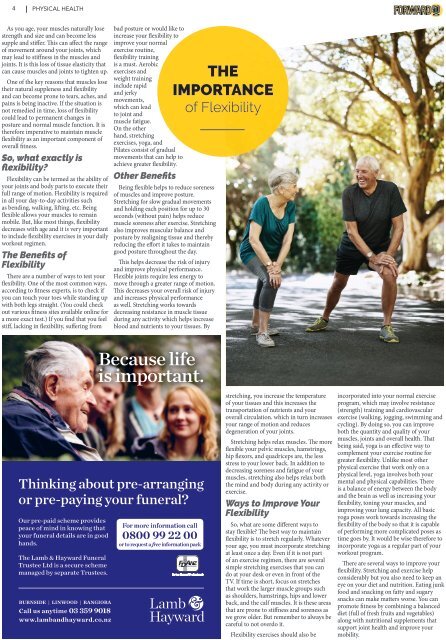The Star: June 28, 2018
Create successful ePaper yourself
Turn your PDF publications into a flip-book with our unique Google optimized e-Paper software.
4 PHysical HealtH<br />
As you age, your muscles naturally lose<br />
strength and size and can become less<br />
supple and stiffer. This can affect the range<br />
of movement around your joints, which<br />
may lead to stiffness in the muscles and<br />
joints. It is this loss of tissue elasticity that<br />
can cause muscles and joints to tighten up.<br />
One of the key reasons that muscles lose<br />
their natural suppleness and flexibility<br />
and can become prone to tears, aches, and<br />
pains is being inactive. If the situation is<br />
not remedied in time, loss of flexibility<br />
could lead to permanent changes in<br />
posture and normal muscle function. It is<br />
therefore imperative to maintain muscle<br />
flexibility as an important component of<br />
overall fitness.<br />
So, what exactly is<br />
flexibility?<br />
Flexibility can be termed as the ability of<br />
your joints and body parts to execute their<br />
full range of motion. Flexibility is required<br />
in all your day-to-day activities such<br />
as bending, walking, lifting, etc. Being<br />
flexible allows your muscles to remain<br />
mobile. But, like most things, flexibility<br />
decreases with age and it is very important<br />
to include flexibility exercises in your daily<br />
workout regimen.<br />
<strong>The</strong> Benefits of<br />
Flexibility<br />
<strong>The</strong>re are a number of ways to test your<br />
flexibility. One of the most common ways,<br />
according to fitness experts, is to check if<br />
you can touch your toes while standing up<br />
with both legs straight. (You could check<br />
out various fitness sites available online for<br />
a more exact test.) If you find that you feel<br />
stiff, lacking in flexibility, suffering from<br />
bad posture or would like to<br />
increase your flexibility to<br />
improve your normal<br />
exercise routine,<br />
flexibility training<br />
is a must. Aerobic<br />
exercises and<br />
weight training<br />
include rapid<br />
and jerky<br />
movements,<br />
which can lead<br />
to joint and<br />
muscle fatigue.<br />
On the other<br />
hand, stretching<br />
exercises, yoga, and<br />
Pilates consist of gradual<br />
movements that can help to<br />
achieve greater flexibility.<br />
Other Benefits<br />
Being flexible helps to reduce soreness<br />
of muscles and improve posture.<br />
Stretching for slow gradual movements<br />
and holding each position for up to 30<br />
seconds (without pain) helps reduce<br />
muscle soreness after exercise. Stretching<br />
also improves muscular balance and<br />
posture by realigning tissue and thereby<br />
reducing the effort it takes to maintain<br />
good posture throughout the day.<br />
This helps decrease the risk of injury<br />
and improve physical performance.<br />
Flexible joints require less energy to<br />
move through a greater range of motion.<br />
This decreases your overall risk of injury<br />
and increases physical performance<br />
as well. Stretching works towards<br />
decreasing resistance in muscle tissue<br />
during any activity which helps increase<br />
blood and nutrients to your tissues. By<br />
tHE<br />
ImPoRtANCE<br />
of Flexibility<br />
Our pre-paid scheme provides<br />
peace of mind in knowing that<br />
your funeral details are in good<br />
hands.<br />
<strong>The</strong> Lamb & Hayward Funeral<br />
Trustee Ltd is a secure scheme<br />
managed by separate Trustees.<br />
For more information call<br />
0800 99 22 00<br />
or to request a free information pack<br />
stretching, you increase the temperature<br />
of your tissues and this increases the<br />
transportation of nutrients and your<br />
overall circulation. which in turn increases<br />
your range of motion and reduces<br />
degeneration of your joints.<br />
Stretching helps relax muscles. <strong>The</strong> more<br />
flexible your pelvic muscles, hamstrings,<br />
hip flexors, and quadriceps are, the less<br />
stress to your lower back. In addition to<br />
decreasing soreness and fatigue of your<br />
muscles, stretching also helps relax both<br />
the mind and body during any activity or<br />
exercise.<br />
Ways to Improve Your<br />
Flexibility<br />
So, what are some different ways to<br />
stay flexible? <strong>The</strong> best way to maintain<br />
flexibility is to stretch regularly. Whatever<br />
your age, you must incorporate stretching<br />
at least once a day. Even if it is not part<br />
of an exercise regimen, there are several<br />
simple stretching exercises that you can<br />
do at your desk or even in front of the<br />
TV. If time is short, focus on stretches<br />
that work the larger muscle groups such<br />
as shoulders, hamstrings, hips and lower<br />
back, and the calf muscles. It is these areas<br />
that are prone to stiffness and soreness as<br />
we grow older. But remember to always be<br />
careful to not overdo it.<br />
Flexibility exercises should also be<br />
incorporated into your normal exercise<br />
program, which may involve resistance<br />
(strength) training and cardiovascular<br />
exercise (walking, jogging, swimming and<br />
cycling). By doing so, you can improve<br />
both the quantity and quality of your<br />
muscles, joints and overall health. That<br />
being said, yoga is an effective way to<br />
complement your exercise routine for<br />
greater flexibility. Unlike most other<br />
physical exercise that work only on a<br />
physical level, yoga involves both your<br />
mental and physical capabilities. <strong>The</strong>re<br />
is a balance of energy between the body<br />
and the brain as well as increasing your<br />
flexibility, toning your muscles, and<br />
improving your lung capacity. All basic<br />
yoga poses work towards increasing the<br />
flexibility of the body so that it is capable<br />
of performing more complicated poses as<br />
time goes by. It would be wise therefore to<br />
incorporate yoga as a regular part of your<br />
workout program.<br />
<strong>The</strong>re are several ways to improve your<br />
flexibility. Stretching and exercise help<br />
considerably but you also need to keep an<br />
eye on your diet and nutrition. Eating junk<br />
food and snacking on fatty and sugary<br />
snacks can make matters worse. You can<br />
promote fitness by combining a balanced<br />
diet (full of fresh fruits and vegetables)<br />
along with nutritional supplements that<br />
support joint health and improve your<br />
mobility.


















